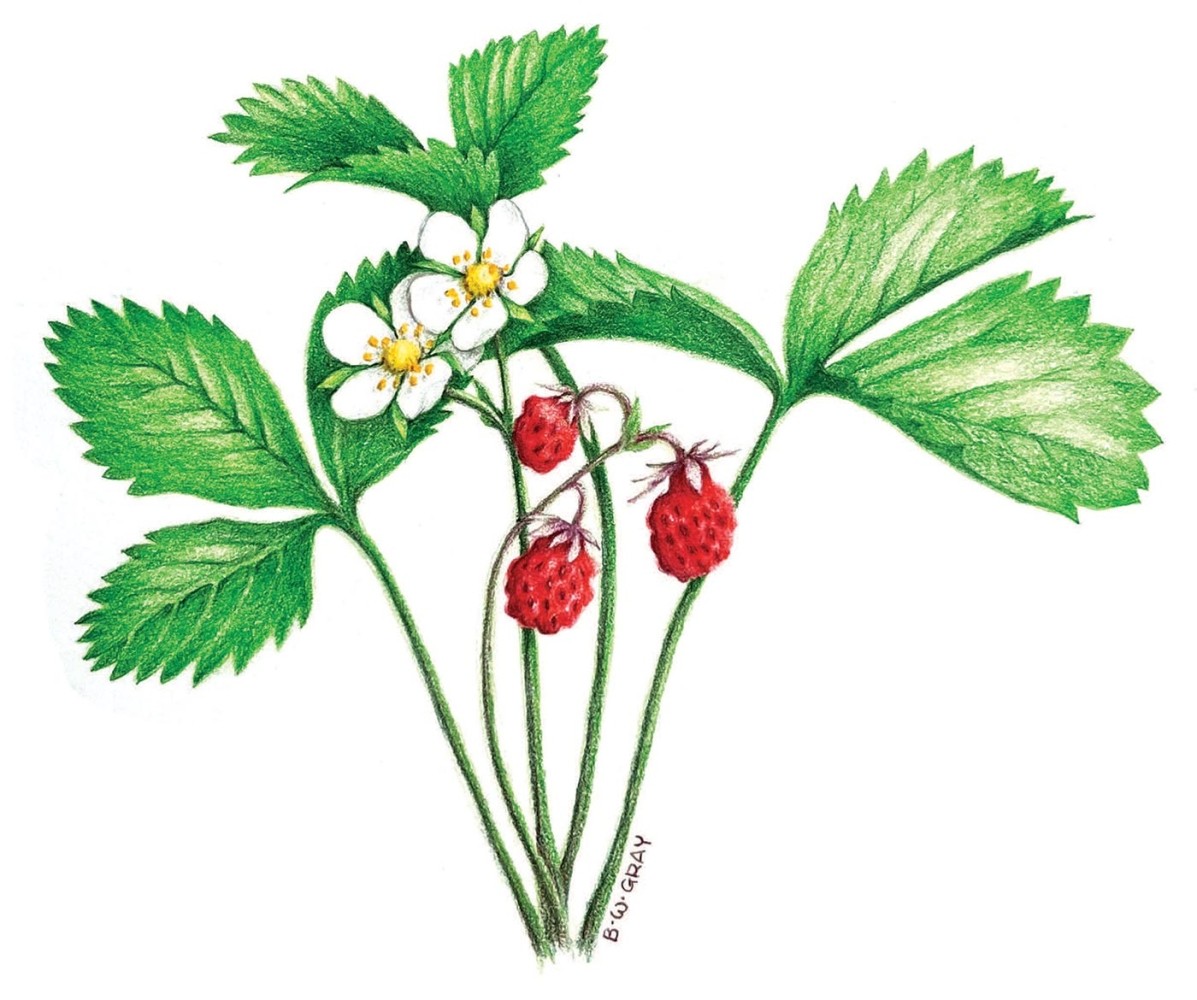As a science teacher, I love strawberries not just for their flavor, but also for their DNA. I use strawberries to show high school students how to extract DNA from living tissue. A quirk of their genetics makes strawberries ideal for this. And for a new forager, wild strawberries make an ideal first experience of gathering from nature’s garden.
When I say wild strawberries, I am really referring to two closely related species. The common wild strawberry (Fragaria virginiana) is, as its name suggests, the one you are most likely to find. It grows among the grasses in nitrogen-poor, sunny fields and roadsides. By contrast, the wood strawberry (F. vesca) often grows in forested openings.
Both species bear an unmistakable resemblance to the cultivated strawberries of the garden (F. x ananassa) but with tiny, almost fairy-size, berries. As with the garden variety, wild strawberries are low-growing herbs, usually no more than 6 inches tall, that spread by runners. Their long, hairy stalks support three coarsely toothed leaflets and, later in spring, separate stalks support white flowers with five almost-round petals that bloom in clusters of two to ten. Of course, both plants produce juicy, red, seed-covered fruit.
There is little need to differentiate between the common and wood species, but if you are so inclined, there are two clear ways to distinguish them. The first is by their seeds. The seeds of the common strawberry are sunken into little pits on the surface of the berry, while the seeds of the wood strawberry protrude. The second is by the height of the stalks that produce flowers and fruits. In the common strawberry, these stalks tend to be lower than the leaves, while in the wood strawberry, they typically rise above the leaves.
I know of no poisonous plants that are likely to confuse the wild strawberry-picker. Goldthread (Coptis groenlandica) is a low-growing herb with three leaflets and white, five-petaled flowers. But its fruits look more like pea pods than like strawberries, and its petals are thin and pointed. I have never seen the so-called Indian strawberry (Duchesnea indica) because it grows to the south, beyond my foraging range. Its fruit does look remarkably strawberry-like, but its yellow flowers, pointed leaves, and three-toothed bracts that extend beyond the petals are clear tells. The fruit is not poisonous, just disappointingly flavorless.
To gather wild strawberries, watch for the flowers that bloom in early spring, and wait until they drop their petals. Then be vigilant as the berries change to red. You can be certain that your competitors, which include birds and every mouse, chipmunk, and squirrel in the vicinity, will be watching, too. When harvest days arrive, usually in early June, you only need sunscreen, a small container, and patience.
Because they are so tiny, wild strawberries are slow to gather. Wild food author Thomas Elpel reports that, in Montana, he collects about 1 cup of berries in an hour. Master forager Samuel Thayer, who lives in Wisconsin, says that when conditions are right, he can gather up to a gallon in the same amount of time. Here in New England, I pick about 2 to 3 cups per hour, although it is hard to obtain an exact estimate when so many berries go straight into my mouth.
I’ve been asked if wild strawberries would make a good jam. I am sure they would, but I can’t imagine ever wanting to jam them. The flavor of fresh, raw wild strawberries is unparalleled. Anything that requires cooking or combining them seems a waste. If you have so many berries that you need to preserve them, perhaps you just need to find more berry-loving friends.
Strawberries are a remarkable fruit in so many ways. But one needn’t understand their peculiar life cycle or the finer points of their genetics to appreciate their explosive flavor. After years of foraging, I am still amazed that such a tiny fruit can pack so much flavor as to put their oversize supermarket cousins to shame. It is a flavor that, quite literally, money cannot buy.


